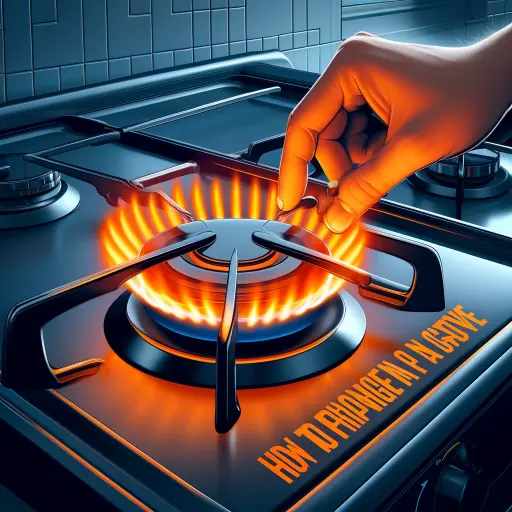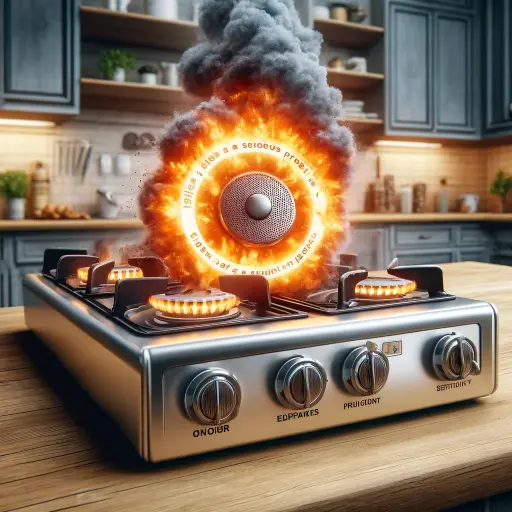How to Fix an Orange Flame on a Gas Stove?
Updated: 15 Oct 2023
852
Have you ever looked at your gas stove and seen an orange flame instead of a clear blue one? You’re not the only one who has seen this. A blue flame means your stove is working well, but an orange flame could mean there’s a problem.
Let’s find out why this happens and how you can fix it. This common issue might seem inconsequential, but understanding it is vital.
Safety can’t be overstated. A gas stove with an orange flame might be telling you there’s a problem that needs attention. Ignoring it can lead to more serious issues like gas leaks and even potential fire hazards.

In this article, we’ll take a deep dive into the root causes of an orange flame on a gas stove, providing simple and practical solutions for fixing it.
Understanding the Orange Flame
Let us first understand the issue:
1. What Causes an Orange Flame on a Gas Stove?
- Explanation of Incomplete Combustion: Incomplete combustion happens when the gas doesn’t burn completely. This can occur due to various factors, and it’s one of the main culprits behind an orange flame.
- Factors Influencing Flame Color: Several factors, including the type of gas and the air-to-gas ratio, can influence the color of the flame. Understanding these factors will help us in troubleshooting the issue.
2. Is an Orange Flame Dangerous?
An orange is not a proper flame on a gas stove. This flame can pose certain risks:
- Risks Associated with an Improper Flame: Apart from inefficiency, an improperly burning flame can lead to the release of harmful byproducts like carbon monoxide.
- Potential Safety Hazards: Ignoring an orange flame can lead to more serious problems, including gas leaks or even fires.
How To Fix an Orange Flame on a Gas Stove? 11 Easy Steps
If you’ve noticed an orange flame on your gas stove, don’t worry – it’s a common issue that can be resolved with a few simple steps.
Follow these eleven easy-to-implement solutions to ensure your stove is operating efficiently and safely.

- Turn Off the Gas Supply: Before you start any maintenance, ensure the gas supply to the stove is switched off. Safety is paramount.
- Allow the Burners to Cool: Wait for the burners to cool down completely before proceeding. This will prevent any accidental burns.
- Clean the Burner Ports: Use a soft brush or a pin to clear any debris or residue from the burner ports. This obstruction can disrupt the combustion process, leading to an orange flame.
- Inspect the Burner Caps: Remove the burner caps and clean them thoroughly. Ensure there’s no grease, dirt, or residue affecting the flame.
- Check for Gas Leaks: Use a mixture of water and dish soap to check for gas leaks. Apply it around the connections and valves. Bubbles indicate a leak, in which case, seek professional help.
- Adjust the Air Shutter: Locate the air shutter, usually near the burner. Gradually open or close it until the flame turns blue. This controls the air-to-gas ratio.
- Inspect the Gas Pressure: If possible, check the gas pressure with a gauge. If it’s not within the recommended range, contact a professional technician.
- Clean the Gas Orifice: Use a needle or pin to clean the gas orifice, ensuring there are no obstructions that might disrupt the flow of gas.
- Verify the Gas Type: Confirm that your stove is set up for the correct type of gas (natural gas or propane). Using the wrong type can lead to improper combustion.
- Adjust for High Altitudes: If you live at a high altitude, you may need to adjust the burner for optimal combustion. Refer to the manufacturer’s guidelines.
- Test and Observe: Turn on the gas and ignite the burner. Observe the flame. It should now be a steady, blue color. If not, recheck the steps or seek professional assistance.
DIY Solutions for Correcting an Orange Flame
Common DIY Fixes for Orange Flames
If you’re experiencing an orange flame, try these common solutions:
- Checking for Obstructions: Inspect the burner ports for any debris or blockages. Clear them using a soft brush or a pin.
- Inspecting Gas Lines and Connections: Ensure all gas lines and connections are secure and free from leaks. Use a soapy water solution to check for bubbles, which indicate a leak.
Addressing Specific Issues
- Yellow Tips or Uneven Flames: Adjust the air shutter to achieve the proper air-to-gas ratio. This should result in a more even, blue flame.
- Sooting or Carbon Buildup: Clean the burners thoroughly to remove any accumulated soot or carbon. Use a soft brush and mild detergent for effective cleaning.
Can an Orange Flame Indicate a Gas Leak?
An orange flame on your gas stove can indeed be an indicator of a potential gas leak. Recognizing this early can prevent serious safety hazards. Look out for these warning signs:

- Smell: Natural gas is odorless, but utility companies add a distinctive odor (often compared to rotten eggs) to help detect leaks. If you notice this smell near your stove, take it seriously.
- Hissing Sound: If you hear a hissing sound near your gas stove, it could be a sign of a leak. This indicates the gas is escaping from a pipeline or a connection.
Immediate Actions to Take in Case of Suspicion
- Do Not Ignite Anything: Avoid using any flames or electrical appliances, including light switches. A spark could trigger an explosion.
- Ventilate the Area: Open windows and doors to allow fresh air in and help disperse the gas.
- Turn Off the Gas: If it’s safe to do so, turn off the gas supply at the main valve. Do this only if you’re familiar with the process.
- Leave the Area: If you continue to suspect a gas leak, leave the premises and contact your gas provider or emergency services immediately.
Gas Combustion Basics

How Does Gas Combustion Work?
Understanding the combustion process is crucial in maintaining a safe and efficient gas stove:
- Overview of Combustion Process: Gas combustion is a chemical reaction between the fuel (gas) and oxygen in the air. This reaction produces heat, water vapor, and carbon dioxide.
- Role of Oxygen and Fuel Ratio: The right balance of oxygen and fuel is necessary for complete combustion. Too much or too little of either can lead to an inefficient flame.
Types of Gas Stove Flame Colors
- Natural Gas vs. Propane: Different gases require different air-to-fuel ratios for optimal combustion. It’s essential to ensure your stove is set up for the correct type of gas.
- Expected Flame Colors for Different Gases: Natural gas typically produces a blue flame, while propane burns with a slightly different color. Understanding these differences helps troubleshoot flame issues.
How Altitude Affects Gas Combustion and Flame Color
- Explanation of Pressure and Combustion: At higher altitudes, the air pressure is lower, affecting the air-to-gas ratio. This can lead to variations in flame color.
- Adjustments Needed at High Altitudes: If you live at a high altitude, it may be necessary to make adjustments to your stove to ensure proper combustion and flame color.
Cleaning Gas Burners for Optimal Flame
Regularly cleaning your gas burners is crucial for maintaining a safe and efficient stove:

- Impact on Flame Quality and Efficiency: Clean burners ensure a consistent and efficient flame. This leads to better heat distribution and cooking performance.
- Preventing Blockages and Uneven Burning: Over time, debris and residue can accumulate, obstructing the flow of gas. This can lead to uneven flames and incomplete combustion.
When to Seek Professional Help

It’s crucial to recognize signs that indicate a more complex issue with your gas stove:
Indicators of More Complex Issues
- Persistent orange flame despite adjustments.
- Unusual noises like popping or rumbling.
- Soot buildup on burners or cookware.
Potential Risks of Not Seeking Professional Assistance
- Increased risk of gas leaks and associated dangers
- Reduced stove efficiency leading to higher energy bills
- Compromised air quality due to incomplete combustion
Common Mistakes to Avoid

Avoid the following common missteps that could worsen the situation:
Missteps That Could Worsen the Situation
- Ignoring persistent issues with the flame color.
- Attempting complex repairs without proper knowledge or tools.
Ensuring a Safe and Effective Resolution
- Prioritize safety and seek professional help if you’re unsure about any aspect of gas stove maintenance.
- Follow manufacturer guidelines for maintenance and troubleshooting.
Conclusion
In closing, addressing an orange flame on your gas stove is not only about aesthetics but also about ensuring your safety and the efficient operation of your appliance.
We’ve covered an array of solutions to guide you through the process, from understanding the root causes of the issue to taking steps to resolve it.
Remember, a properly functioning gas stove not only enhances your culinary experience but also contributes to a safer and more energy-efficient home.


Please Write Your Comments